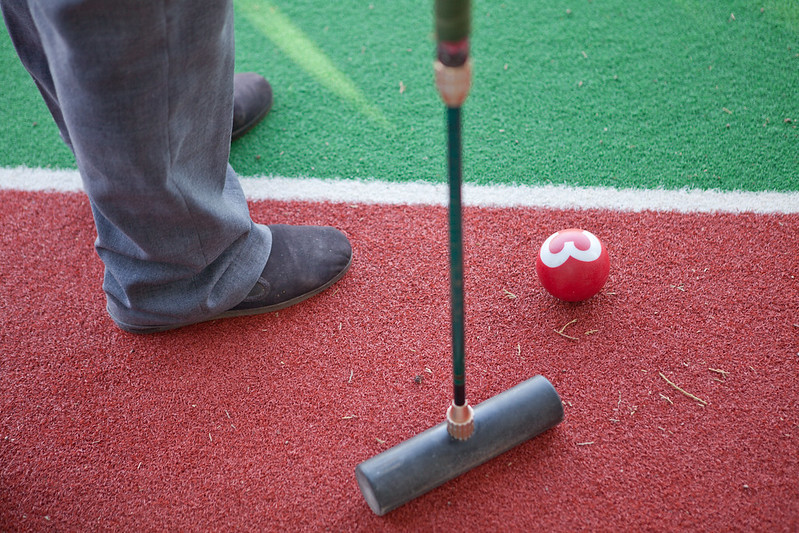This article will examine the increasing popularity of Gateball, the straightforward rules that make it easy for people of all ages to play, and how it fosters social connections and cultural exchanges. As gateball spreads to different regions, we will consider the impact this has on local communities and the sport’s identity on a global scale.
What is Gateball?
Gateball is a fast-paced, non-contact mallet sport that originated in Japan in 1947. Played on a rectangular court, two teams compete to score points by navigating their balls through gates and hitting a goal pole. It promotes teamwork, strategic thinking, and is accessible to players of all ages and genders globally.
Gateball has gained popularity in countries like China, Indonesia, Japan, South Korea, and Taiwan since its inception in Japan in the 1940s. As it continues to grow globally, it offers a rewarding team experience that emphasizes skill and social interaction.
In a time when collaboration is important, Gateball highlights the enjoyment found in friendly competition and shared objectives. As more people discover this vibrant sport, Gateball is poised to play an important role in the international sports scene.
History of Gateball
Gateball is a unique sport that originated in Japan, created by Suzuki Kazunobu in 1947. It emerged during a time when rubber was scarce, prompting Suzuki, who was involved in the lumber industry in Hokkaido, to use wood for making balls and mallets. He adapted croquet’s rules to design Gateball, focusing on making it accessible for younger players.
The game began to gain popularity in the late 1950s, thanks to a physical education instructor who introduced it to women’s groups and senior citizens in Kumamoto City. In 1962, members of the Kumamoto Gateball Association formed the organization, which helped establish standardized rules. Gateball’s visibility increased significantly after a demonstration at a national fitness event in Kumamoto in 1976, supported by local officials and senior organizations.
In 1984, the Japanese Gateball Union (JGU) was formed under the leadership of Ryoichi Sasakawa. This organization standardized the game’s rules and held the first national meet. By 1985, the JGU had partnered with other countries to create the World Gateball Union (WGU), which has continued to grow in membership.
| Year | Significant Event |
|---|---|
| 1947 | Suzuki Kazunobu invents Gateball |
| 1962 | Formation of Kumamoto Gateball Association |
| 1984 | Establishment of the Japanese Gateball Union |
Gateball Court
Gateball has become a well-loved sport with specific guidelines for its playing area. In this article, we’ll explore the standard dimensions of a Gateball court, the setup of gates and goal poles, team structure, and the overall gameplay experience.
A typical Gateball court measures 20 meters long and 15 meters wide, creating a rectangular space that encourages strategic play. This layout is important for maintaining consistency in various locations where the game is enjoyed.
The court includes three gates and a goal pole, each positioned to test players’ skills. Players must skillfully navigate their balls through the gates and aim for the goal pole at the end of the court to score points.

Gameplay
Games are played by two teams, each with up to five players. Team members use numbered balls—odd numbers are red, and even numbers are white. This color coding helps players and spectators easily follow the action on the field.
A standard game lasts for 30 minutes, creating an exciting atmosphere where teams compete for the highest score. The combination of court dimensions and the strategic placement of gates and the goal pole fosters a lively environment that encourages creativity and engagement. The design of the court not only sets the stage for play but also reflects the spirit of strategy and fun that makes Gateball enjoyable.
Gateball Rules
Gateball is an engaging sport where two teams, each made up of five players in red and white, compete to score points by passing through gates and hitting a goal-pole. The game unfolds over 30 minutes, with players taking turns in a specific order—starting with red 1, then white 2, and continuing in that pattern until the time runs out.
Key aspects of the game include:
| Action | Description |
|---|---|
| Start of Game | The chief referee signals the start with “Play ball.” |
| Scoring | Earn one point for each gate passed; hitting the goal earns two points. |
| Turn Sequence | Players alternate turns between red and white. |
| End of Game Conditions | The game concludes after the last player’s turn when time expires. |
| Perfect Game | The game ends immediately if all five balls from one team finish. |
Gateball Competitions
Gateball competitions have gained notable global interest, especially through events like the World Games and the World Gateball Championships. The sport made its debut as an exhibition event at the World Games in 2001, held in Akita Prefecture, Japan, which significantly boosted its international profile. That year, teams from countries such as China, Japan, South Korea, the United States, and Chinese Taipei participated. A predominantly teenage Japanese team took home the trophy.
The World Gateball Championships, initiated in 1986, further showcased the sport’s growing international presence. These championships occur every four years, featuring teams from various nations. The first championship in Hokkaido saw participation from Brazil, China, Chinese Taipei, Japan, Korea, and the USA. Subsequent events hosted places like Hawaii and Shanghai, with the 10th Championship in Shanghai in 2010 attracting 96 teams from 14 countries, which highlights the sport’s expanding reach.
The 13th World Gateball Championship, originally set for 2022, was postponed due to the COVID-19 pandemic, which caused widespread travel restrictions. As a result, the event has been rescheduled for 2026, aligning with the 14th Championship. Despite these setbacks, the passion for competition and camaraderie in gateball remains strong. It unites players and fans across the globe in their shared love for the game.
Current situation in the world
Interest in gateball is growing worldwide, showcasing a vibrant community around the sport. This article will explore its popularity in various regions, the player demographics, and how the game fosters connections across cultures.
Asia is leading in gateball participation, with China and Japan at the forefront. China has around ten million players and has achieved success in multiple World Gateball Championships. In contrast, Japan, the game’s birthplace, has about two million players focused on honing their skills.
Outside Asia, gateball is making strides in South America, North America, Oceania, and Europe. In Brazil, players of Japanese descent are particularly notable for their expertise. Australia has also embraced the sport, with croquet enthusiasts exploring gateball as a new hobby. In Europe, volunteer-led events are boosting interest, and in Africa, collaborations with local croquet players are introducing the game.
The following table highlights the global reach of gateball and its active communities:
| Region | Notable Features |
|---|---|
| Asia | Largest player base, China and Japan lead |
| South America | Strong participation among Japanese immigrants |
| North America | Friendship matches between American and Japanese players |
| Oceania | Australian croquet players exploring gateball |
As gateball grows in various regions, it promotes camaraderie and inclusivity, bringing together players from diverse backgrounds and creating lasting friendships.

